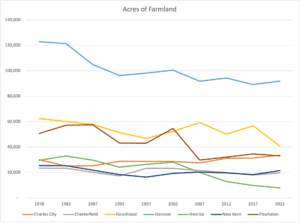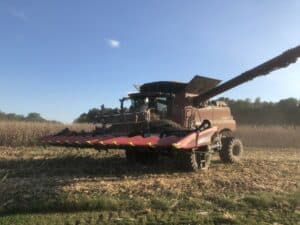Latest Data from The US Census of Agriculture Shows Virginia Lost More Farmland in the Last Five Years Than in the Previous Fifteen
 Farms Under Threat: The State of the States is a report issued by the American Farmland Trust in 2020 to highlight the threats facing working farms and ranches in every state and how each state responded with policy. At the time, Virginia had a high threat with a medium response. The report noted that Virginia ranked 8th in the nation for conversion of farmland to urban highly developed and low-density residential land use between 2001 and 2016. Some 340,000 acres were removed from agricultural production. In fact, I wrote about this in an April 2021 blog post.
Farms Under Threat: The State of the States is a report issued by the American Farmland Trust in 2020 to highlight the threats facing working farms and ranches in every state and how each state responded with policy. At the time, Virginia had a high threat with a medium response. The report noted that Virginia ranked 8th in the nation for conversion of farmland to urban highly developed and low-density residential land use between 2001 and 2016. Some 340,000 acres were removed from agricultural production. In fact, I wrote about this in an April 2021 blog post.
Perhaps more astonishing than the 2020 report is recently released data about the state of Virginia’s agriculture in 2022 from the United States Census of Agriculture. According to this new data released February 13, 2024, Virginia lost more farmland between 2017 and 2022 than it did in the previous 15 years; meaning more than 488,000 acres of farmland were converted to some other use. Equally depressing is that 10% of all Virginia farms ceased to operate during the same time period.
 Land conversion and loss of farms noted by the US Census of Agriculture should raise alarms for state and local officials. The agriculture industry, which provides more than 381,800 jobs in the Commonwealth, has an $82.3 billion annual economic impact. A 2021 report from the Weldon Cooper Center for Public Service explains in detail the benefits of agriculture and forestry on Virginia’s gross domestic product. In fact, 9.3% of the state gross domestic product comes from these two industries while they represent 9.4% of the total state employment. “Approximately one of every eleven jobs in Virginia can be tied to its agriculture and forest industries.”
Land conversion and loss of farms noted by the US Census of Agriculture should raise alarms for state and local officials. The agriculture industry, which provides more than 381,800 jobs in the Commonwealth, has an $82.3 billion annual economic impact. A 2021 report from the Weldon Cooper Center for Public Service explains in detail the benefits of agriculture and forestry on Virginia’s gross domestic product. In fact, 9.3% of the state gross domestic product comes from these two industries while they represent 9.4% of the total state employment. “Approximately one of every eleven jobs in Virginia can be tied to its agriculture and forest industries.”
What’s happening in the Richmond region (Charles City, Chesterfield, Goochland, Hanover, Henrico, New Kent and Powhatan) is a mixed bag. The US Census of Agriculture notes that the region lost 9,632 acres of farmland and 227 farms along with it. That represents a loss of over 13% of farms.
Most notable in the 2022 US Census of Agriculture report is Goochland County. During the 5 years between 2017 and 2022, Goochland lost 28% of its farmland and 24% of its farms all while its population grew 15%. Likewise, New Kent County’s population grew by 15% during the same period and it lost more than 18% of its farms. Farmland acres, however, grew in New Kent by more than 3,000 acres due in no small part to the efforts of John Poindexter and his Tidewater and Big Bend Foundation.
Charles City was the only county where farms increased (9%) and productive farmland grew (2,225 acres). Other localities in the region including Chesterfield, Hanover, Henrico and Powhatan reported declines in the number of farms. However, unusually, Chesterfield, Hanover and New Kent reported an increase in the number of acres in farmland perhaps resulting from the conversion of forested land to agriculture production or possibly inconsistencies in the collection of census data.
 Some hope for farmland preservation in Henrico County came recently with the announcement that the County has purchased the 2,400-acre Varina Plantation with the intention of preserving working farmland and other conservation efforts. However, the data for Henrico County was sobering and only slightly better than Goochland. Henrico lost 1,900 acres of farmland and 15% of its farms leaving just 84 farms. The average farm size in Henrico County is now just 94 acres making it the lowest in the region. The median farm size is also the lowest at 21 acres. All together Henrico County has seen 85% of its farmland converted in the 40 years since the 1982 US Census of Agriculture. Just about 4% of the total land area of Henrico is currently farmed with 0.02 acres of farmland per capita.
Some hope for farmland preservation in Henrico County came recently with the announcement that the County has purchased the 2,400-acre Varina Plantation with the intention of preserving working farmland and other conservation efforts. However, the data for Henrico County was sobering and only slightly better than Goochland. Henrico lost 1,900 acres of farmland and 15% of its farms leaving just 84 farms. The average farm size in Henrico County is now just 94 acres making it the lowest in the region. The median farm size is also the lowest at 21 acres. All together Henrico County has seen 85% of its farmland converted in the 40 years since the 1982 US Census of Agriculture. Just about 4% of the total land area of Henrico is currently farmed with 0.02 acres of farmland per capita.
Chesterfield County has twice the acres of farmland per capita than Henrico County at 0.05 acres. However, the 2022 US Census of Agriculture reported a drop of nearly 23% in the number of farms. This resulted in a jump in the average farm size from 86 acres to 122. The median farm size is just 30 acres. For comparison, the average farm size in Virginia is 187 acres, median farm size is 62, and about 0.84 acres of farmland per capita. Our region’s farmland and farms are clearly at risk.
Another way of looking at the threat to the Richmond region caused by the loss of farmland is when supply chains break down like occurred during the COVID-19 pandemic. As farms in the region are converted, the distance (and cost) to market increases thus adding more vulnerability and risk. The population centers in Chesterfield, Henrico, and Richmond are not self-sufficient and require food imports. But other localities are also exposed if policies are not urgently implemented to preserve working farms and the rural character.
For example, there are just four dairy farms remaining in the entire Richmond region. Despite Henrico County once being crowned the dairy capital of Virginia, there is not one dairy operation in existence today. The region is now home to just 1% of all dairy farms in the state yet our population accounts for 15% of the total. Where our food comes from in the future has not been resolved and could drive up more food insecurity, prices, and consumption of processed foods which has already spurred a health crisis in America. By visiting any of the numerous farmers markets around the region, we all can help do our part in supporting our local farmers and small batch makers while eating a healthy, whole foods diet and feeling confident in knowing where our food comes from.
Collectively as a region, we can be sustainable from a land use perspective if we have policies to fight the threat that farms continue to face and do more to conserve the land for future agriculture use.
Parker Agelasto, Executive Director

Parker Agelasto
Executive Director


